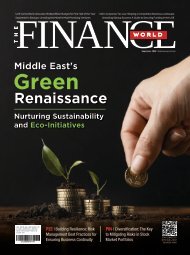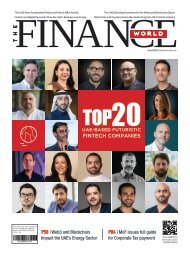The Finance World Magazine| Edition: April 2023
The April edition of The Finance World Magazine (TFW) delves into the world of disruptive investment and its potential to transform markets, featuring an exclusive interview with Hadif Abdullah Zamzam, Senior Associate – Value Creation, Disruptive Investments at Mubadala, who shares his insights on this topic. In addition, we feature interviews with prominent CEOs, including Nilay Ranjan Singh of State Bank India, DIFC, Raman Thiagarajan, CEO & Founder of Zenda, and Naveen Bharadwaj, Group CEO of Trescon. They provide valuable insights on various topics related to business and investments, particularly in the fintech area. Through this edition, we also bring you insights on topics like the UAE and Turkey CEPA agreement that sets the ground for novel business opportunities, cryptocurrency adoption in the UAE and how it is expected to disrupt trade and payment systems, buying and selling properties in Dubai and strategies to boost profitability, and many more articles that offer critical analysis and insights on current trends and issues in the business and investment domains. Keep yourself up to date with all financial sector news with our current news segments. Each person can find something unique from us. We believe our readers deserve real value from what we have to offer.
The April edition of The Finance World Magazine (TFW) delves into the world of disruptive investment and its potential to transform markets, featuring an exclusive interview with Hadif Abdullah Zamzam, Senior Associate – Value Creation, Disruptive Investments at Mubadala, who shares his insights on this topic.
In addition, we feature interviews with prominent CEOs, including Nilay Ranjan Singh of State Bank India, DIFC, Raman Thiagarajan, CEO & Founder of Zenda, and Naveen Bharadwaj, Group CEO of Trescon. They provide valuable insights on various topics related to business and investments, particularly in the fintech area.
Through this edition, we also bring you insights on topics like the UAE and Turkey CEPA agreement that sets the ground for novel business opportunities, cryptocurrency adoption in the UAE and how it is expected to disrupt trade and payment systems, buying and selling properties in Dubai and strategies to boost profitability, and many more articles that offer critical analysis and insights on current trends and issues in the business and investment domains.
Keep yourself up to date with all financial sector news with our current news segments. Each person can find something unique from us. We believe our readers deserve real value from what we have to offer.
Create successful ePaper yourself
Turn your PDF publications into a flip-book with our unique Google optimized e-Paper software.
v<br />
If you are a collector of fine art, you<br />
likely have a clear understanding<br />
of what attracted you to each piece<br />
in your collection. You may even<br />
possess detailed knowledge about<br />
the artists’ personal histories and<br />
creative inspirations. However, you<br />
may not be aware that you can use your<br />
artwork as collateral to obtain a loan,<br />
which can provide liquidity to pursue<br />
various financial opportunities. <strong>The</strong>se<br />
opportunities may include acquiring<br />
additional artwork, financing business<br />
objectives, or taking advantage of other<br />
prospects.<br />
While you may have purchased fine<br />
art primarily for your deep aesthetic<br />
interest and passion, your collection<br />
may also hold significant financial<br />
value. <strong>The</strong> art market has experienced<br />
fluctuations in recent years, and<br />
collector interest has grown in both<br />
established and emerging segments,<br />
meaning the value of your collection<br />
may have changed over time. Utilizing<br />
a fine art loan may be a beneficial<br />
approach to release capital that can<br />
be utilized to achieve other objectives,<br />
such as acquiring more art or investing<br />
in cash flow assets.<br />
Increasingly, affluent art collectors<br />
are taking advantage of low interest<br />
rates by borrowing against their<br />
valuable art collections, including<br />
pieces by renowned artists such as<br />
Picasso and Basquiat. However, this<br />
trend also increases the potential for<br />
a leveraged boom and bust in the art<br />
market. Although the larger banks<br />
currently dominate the art lending<br />
sector due to lower interest rates, art<br />
finance firms and auction houses are<br />
expanding their loan services to draw<br />
in more clients.<br />
According to sources, Sotheby’s is<br />
leading the non-bank category’s efforts<br />
to provide art loans. <strong>The</strong> company’s<br />
art loan portfolio is estimated to be<br />
approximately $1B, and it claims that<br />
this figure increased by 50% between<br />
2021 and 2022, which is impressive<br />
considering the challenges faced in<br />
2021.<br />
Additionally, the firm promotes its<br />
business by providing high-end buyers<br />
with a loan equivalent to 50% of the<br />
hammer price on purchases exceeding<br />
$2M at its auctions, with the entire<br />
process - from application to funding<br />
- taking only 30 days.<br />
It appears that Sotheby’s may soon<br />
provide clients with the option to<br />
securitize personal loans secured by<br />
their art collections. According to<br />
Bloomberg, discussions about this<br />
service are still in the early stages.<br />
Meanwhile, Yieldstreet, an alternative<br />
asset investment company that acquired<br />
the specialist art-secured lender Athena<br />
in 2019, announced that its members<br />
invested $1B on the platform in 2022,<br />
which is their highest ever total. Athena<br />
reports that it has funded over $500M<br />
in the art-lending sector to date.<br />
<strong>The</strong>re are various types of loans<br />
available in the art financing industry,<br />
and different players offer different<br />
services. One type of loan is nonrecourse,<br />
which means that if the<br />
borrower fails to repay, the lender<br />
cannot seize other assets belonging<br />
to the borrower. Borro is an example<br />
of such a lender, and it specializes in<br />
short-term financing for artworks and<br />
other assets. Borro’s interest rates vary<br />
depending on the size of the loan, with<br />
larger loans attracting lower interest<br />
rates. On average, the interest rate is<br />
between 3% and 4% per month.<br />
By borrowing against your fine art<br />
You may unlock the<br />
value of your art<br />
collection to buy<br />
more art or invest<br />
in appreciating<br />
assets and<br />
diversify your<br />
portfolio.<br />
collection, you can use the funds to<br />
purchase additional art or invest in<br />
other assets that have the potential to<br />
appreciate, which can help diversify<br />
your portfolio. Borrowing against a<br />
potentially appreciating asset, like fine<br />
art, can provide positive leverage to<br />
achieve asset diversification.<br />
Additionally, art-related loans<br />
generally have lower interest rates<br />
compared to unsecured loans. Selling<br />
artwork at an inopportune time, such<br />
as when you are exhibiting your<br />
collection, can be avoided by taking<br />
out a loan instead. Furthermore, you<br />
may have a strong personal attachment<br />
to certain pieces in your collection and<br />
prefer not to sell them at auction. By<br />
taking out a loan instead of selling,<br />
you can avoid paying taxes on art sales<br />
that are not as tax-favorable as other<br />
asset classes. You retain ownership<br />
of the art and can still display it as<br />
usual. It may even be loaned out to<br />
galleries or museums, provided there<br />
are appropriate insurance, guarantees,<br />
and other agreements in place.<br />
<strong>April</strong> <strong>2023</strong> www.thefinanceworld.com 97

















